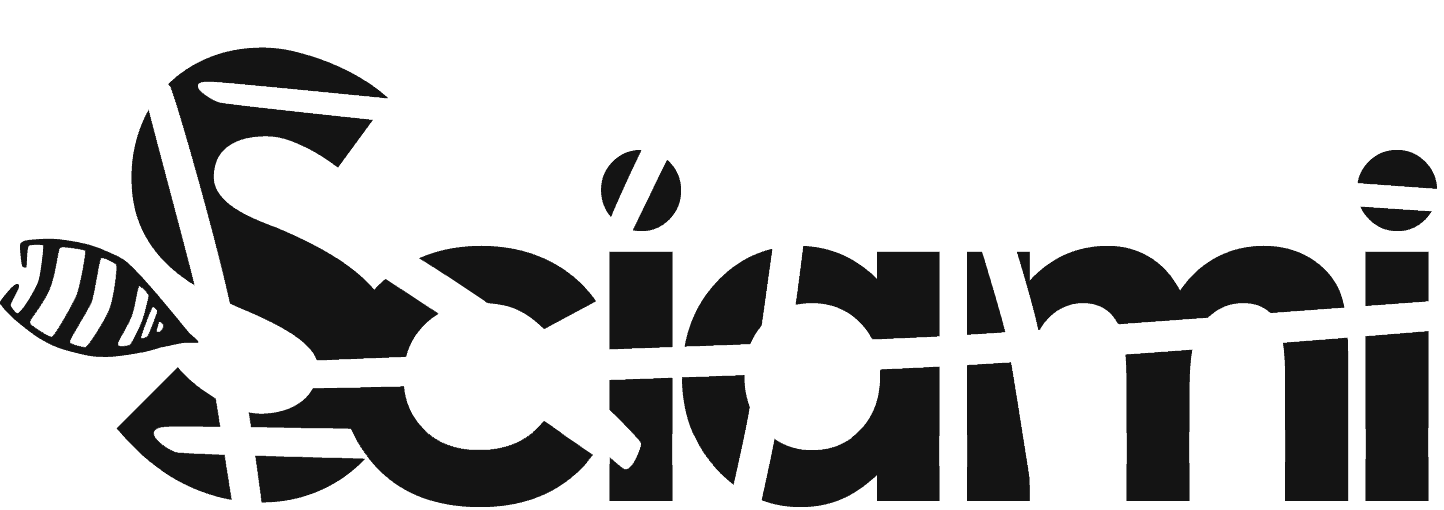This article is also accessible in Italian.
This article deals explores how relationships between bodies and urban environments might be illuminated by concepts of scenographic atmosphere and how that could contribute a new perspective on the understanding of the affective and embodied experience of space. The role of scenography in the planning and development of cities has often been understood as one of urban control and commercial manipulation, but recent research into the reception of scenography as atmosphere foregrounds the co-creative role of individual spectators in the realisation of a scenography. Shifting the focus from the intention of designers to the experience of sensing bodies opens up new ways of thinking about how scenographies, both theatrical and urban, might operate and offers new methodology for investigating how we experience urban environments. This article draws on my sensibility as a scenographer to reflect on my experience of attending to urban atmosphere. My aim is to consider what kind of understanding of urban space emerges when we try to experience the city as scenographic atmosphere.
Introduction
The covid-19 pandemic has transformed the way we engage with and move through cities and brings new focus to relationships between people and the urban environment. Lockdown has made many of us more aware of our relationship with urban space and, especially, how it reflects and influences affective and embodied aspects of urban experience. The sensory, spatial and material qualities of urban space, in particular, seem to heighten awareness of the communicative and performative dimensions of cities. They seem to inform our relationship with urban space in ways that are similar to theatre scenography where light, space, sound and materials enframe the embodied experience of performers and audiences.
My own awareness of the urban environment is heightened; not just in the civic city centre spaces that have been purposefully designed to influence or even manipulate but also in the everyday, ordinary places. With less people and traffic, the features of familiar streets and places come into focus and I notice new things and particular configurations of things such as the variety of colours and textures of an old brick wall, a trail of tarmac patches along the pavement, light and shadow in an alleyway, the silhouette of rooftops against a bright blue sky, a sharp easterly breeze ruffling an arch of hawthorn, the musty smell of a dripping downpipe. I notice the «ordinary affects»1 of the urban environment and the way that these small scenes have the capacity to affect my mood, my imagination and my bodily disposition. The ordinary affects of my urban surroundings come into focus when things seem to coalesce and when there is «a sensation that something is happening»2 emerging from the «charged atmospheres of everyday life»3.
In this article, I use ideas about the formation of atmosphere and draw on my sensibility as a scenographer to reflect on my experience of attending to urban atmosphere. I am using scenographic feeling to attune to the affects of quotidian urban space. My aim is to consider what kind of understanding of urban space emerges when we try to experience the city as scenographic atmosphere.
Urban scenography
There is a long association between scenography and the city. Historical accounts of the development of renaissance scenography point to the correlation between scenic design and urban planning and the way in which theatrical design modelled the ideal city and the compliant behaviour of citizens4. The conception of design as a tool of urban and commercial manipulation, such as in the design of civic spaces or shopping malls, remains influential as part of the «staging» of daily life that is «a basic feature of our society»5. However, an emerging field of “urban scenography” shows how artist-led and participatory scenographic projects can be employed as a critical practice, a way of exploring and critiquing of urban development and imagining how urban space might be differently conceived and used6. The official or hegemonic scenographies of urban planning and commercial development might be unpicked and rethought through scenographic doing and thinking to arrive at alternative scenographies. Jekaterina Lavrinec advocates Situationist-style urban art interventions that articulate urban experience whilst simultaneously «rearranging [the] emotional landscape of the city» and reconceptualising the «spatial structures and social order» that are embedded in urban space7. Playful interaction with theses interventions allows participants to become «active scenographers of their everyday urban surrounding»8. At the same time as scenographies of power and commerce continue to shape and influence urban life, strategic scenographic interventions can also help us to see our surroundings anew and imagine them differently. However, my experience of lockdown walking suggests that there are other scenographic approaches, besides artistic intervention, that might help us to appreciate how quotidian urban environments shape our lives and sense of belonging, or otherwise. I turn now to concepts of scenography that are founded on spectorship and reception rather than on the intervention of artists.
Scenography as atmosphere
Sodja Lotker and Richard Gough seeking to summarise contemporary thinking, define scenographies as places «where bodies and environments collide»9 and, they suggest, a scenographic event does not rely on the presence of a pre-determined scenography; it can simply be «found» by the spectator10through a heightened sense of perception and an act of co-creation. Research into the role of the spectator of scenography confirms the crucial role of their sensing body in the formation of scenographic atmospheres11. The shift towards thinking about scenography as atmosphere rather than artefact was already evident in Adolphe Appia’s aim of creating «the atmosphere of a forest» instead of the «illusion of a forest»12; However, the concept of scenographic atmosphere, especially (but not exclusively) in relation to the use of light, is often «rather shallow»13, in the way it focuses on the establishment of mood or emotion, for example «mysterious, cheerful, or romantic»14. Graham argues for a more complex notion of how light operates in the construction of atmosphere. The «multiple ways in which performance materials can act on spectators»15 means that the designer’s intentions towards the creation of a particular atmosphere will always be modified by the experience of each member of the audience. Furthermore, the agentive capacity of performance materials, such as light, when considered as «an independent, and inter-dependent, material force within performance»16 leads to «myriad ways that atmospheres emerge through the confluence of spaces, objects, and subjects»17.
Chris Salter’s consideration of recent scenographic practice makes the role of “sensing bodies” in the creation of atmospheres even more apparent. He says that the use of light in art and architecture to create «experiences conditioned by spaces and environments» rather than objects has prepared the ground for thinking about the scenographic as an “interlocking” between «atmospheric phenomena like light, heat, vibrations, smells, and air currents and the human inhabitants of these conditions». Scenography, he says, has become «a temporal, spatial, architectural, corporal diffusion»18 where bodies submit to a field of perception. Re-conceiving scenography as the means by which atmospheres form – rather than the creation of objects or environments – emphasises the emergent and “malleable” nature of scenography19 that relies on the bodily presence of spectators for its realisation and completion20. The «active witnessing of the spectator» is central in the examples of the “found” scenographies that Lotker and Gough refer to – in car parks, in the middle of the ocean on a cruise liner, on top of mountains –21; and these found scenographies emerge largely atmospherically, through the perception and imaginative reinvention of the environment that surrounds them.
Urban atmosphere
Meanwhile, from the perspective of urban studies, concepts of atmosphere have been widely discussed22 as a means of investigating the material and sensory impact of urban environments and the way they shape human experience. A significant amount of the literature on urban atmospheres considers the way they are are designed and staged, drawing parallels with the theatre. Jean-Paul Thibaud, for example, evoking theatrical practice as a metaphor, explores the creation of «ambiance» to channel sensations of shoppers, citizens, workers and cultural tourists23. More explicitly, Gernot Böhme cites scenography as a paradigm of atmosphere production24 because of its capability, through set design, light and sound, to attune the audience to the theatrical performance. Scenography, he suggests, offers a theoretical model for thinking about the “theatricalization” of everyday life that manifest in the staging of sporting, cultural and political events as well as in marketing and urban design. But in addition to this, Böhme’s proposal is that the tacit, craft-based knowledge of scenography might provide practical understanding of how atmospheres can be generated. As an example, he points to lighting design, and in particular, to Robert Kümmerlen’s 1929 work on the aesthetics of scenographic principles where «light atmosphere» modulates the stage space and lends all the objects within it a unified and «characteristic mood»25. Böhme’s recognition of the contribution that scenographic practice to wider understanding of atmospheres is a welcome addition to the metaphorical usage of theatre and scenography as models for atmosphere. However, his example drawn from Kümmerlen’s principles – in some respects – reflects a shallow concept of theatrical atmosphere26 because of its insistence on the production of a singular and unified mood which seems to take little account of individual spectators and their bodies as constituent parts of the formation of atmosphere in the way that Salter27suggests. Furthermore, focusing on the application of scenographic knowledge to understand the design and reception of commercial events and urban spectacles falls back on a narrow view of scenography as a tool of suggestion, manipulation and control and the public as mere observers and consumers. In contrast, the examples of urban scenography above and research that explores scenography from the perspective of its capacity to open up to «open up to change, multiple uses and transformative experiences»28 position scenography as a means of rethinking urban space and spectators as co-creators of scenographic atmosphere.
The practice of scenography offers more than one model for the generation of atmosphere, especially when it comes to understanding the «charged atmospheres» of everyday life. Boehme admits that his proposal of scenography as a paradigm ‘falls short’ when considering the city dwellers as inhabitants and participants in daily life, rather than distanced observers.
I suggest that the concept of audience as co-creators of theatrical atmosphere, entangled within a network of human and non-human things29 or caught up in a «self generating and ever-changing autopoietic feedback loop»30 provides another way to think about how scenography and urban atmospheres. In the following section I will use some examples from my lockdown walks to explore the idea of scenographic co-creation of urban atmospheres further.
Light, space and found scenographies
I now turn to five examples of moments of “found” scenographic atmospheres, encountered on my walks and reflected here through photographs and notes. The photographs are taken with my phone and used as reminders of what it felt like to be in that exact spot. I have tried to record my predominant impressions and sensations at that moment, but these are often inflected with past experiences and knowledge of the places, too. Each of them reflect the way that atmospheres are both subjective and objective; «always sensed only in one’s own disposition» and, at the same time, sensed as «something emanating from other people, things or the environment»31.
In this particular selection, light plays a leading role, but always in combination with other spatial and material elements.
Walk to the train station: Sylvester Street, Sheffield, 6.55 am, 22 September, 2020
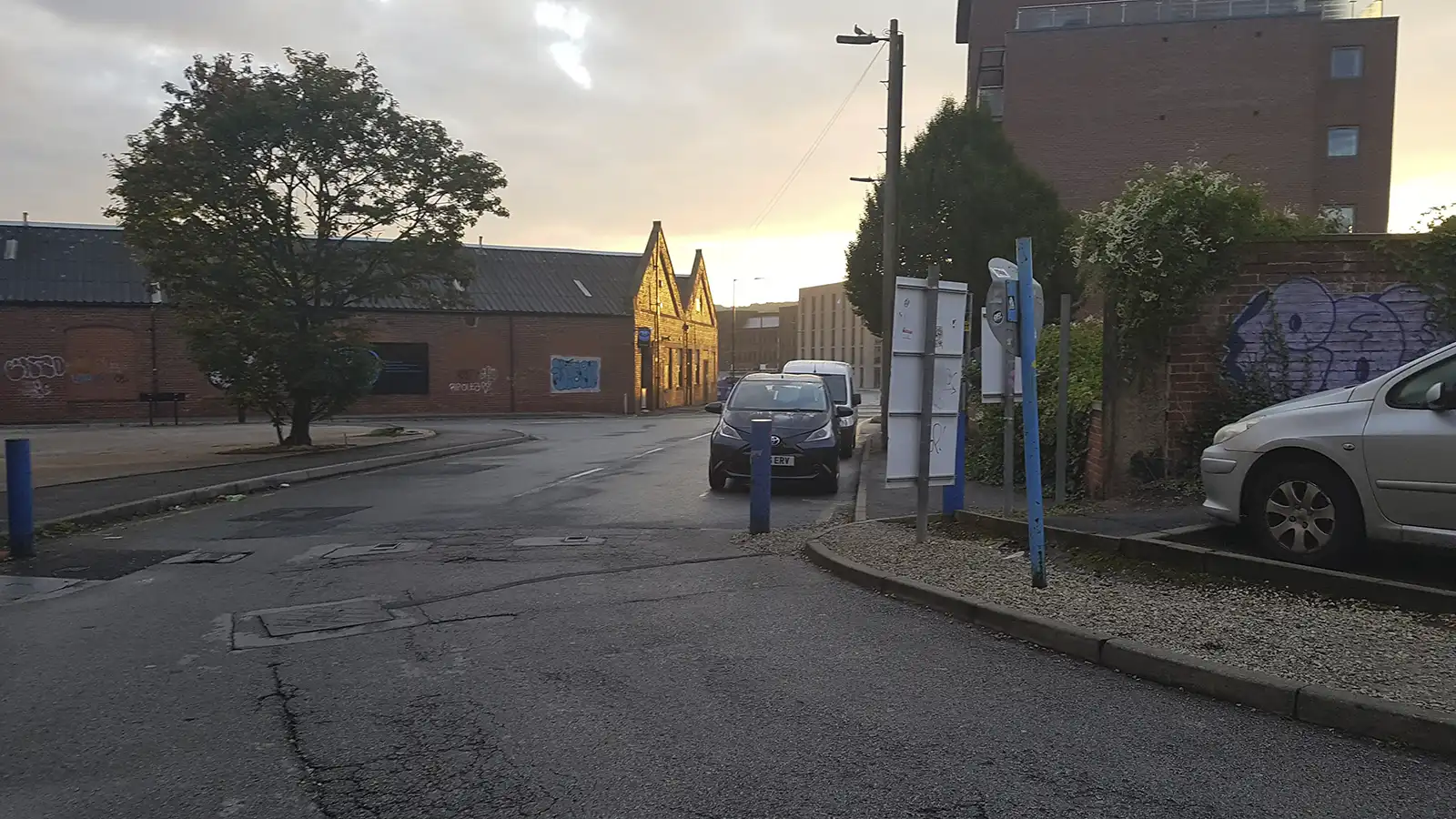
The double-gabled building in the distance is spot-lit by early-morning sun; worn red bricks glowing orange. It acts like a beacon that pulls me towards it along the curving path. The low angle of the light picks out the patched tarmac surface of the road. It’s part of the city that has been under continuous change and repair over the last 10 years; old buildings nineteenth-century cutlery works have been converted into accommodation or pulled down and replaced with new builds. Two temporary car parks currently mark space for future developments. Nothing seems fixed. This point of my walk to the station is often where I am aware of things (on a smaller scale than buildings) subtly shifting, re-arranging themselves. Today, there is moisture in the air that gives a hazy thickness to the sunlight. Through that, the orange glow of the bricks and the fainter glow of the sunrise make small points of contrast with the blue posts and graffiti, punctuating the vista.
Walk to the train station: Waitrose supermarket, Ecclesall Road, Sheffield, 6.50 am, 9 October 2020
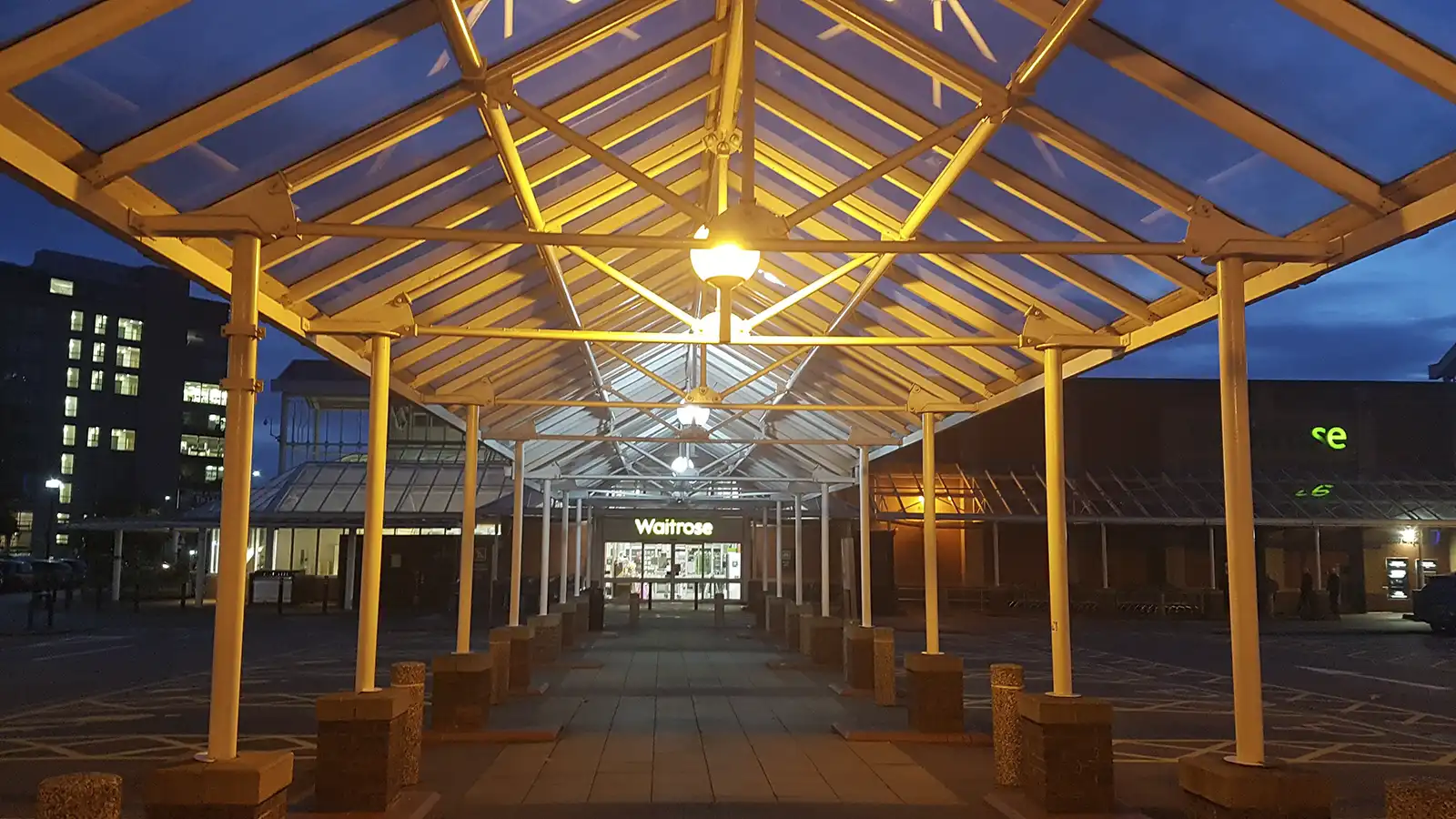
A grandiose entrance to a Waitrose supermarket. Early in the morning, before the supermarket is open, the lamps throw a light across the structure that appears golden, lending it even more ironic sense of splendour than usual. Despite myself, I’m enjoying the feeling of walking down the colonnade, standing a little taller than usual, aware of my pace and a slight lift in my step.
Early morning walk: Ecclesall Road, Sheffield, 6.50 am 20 May 2020
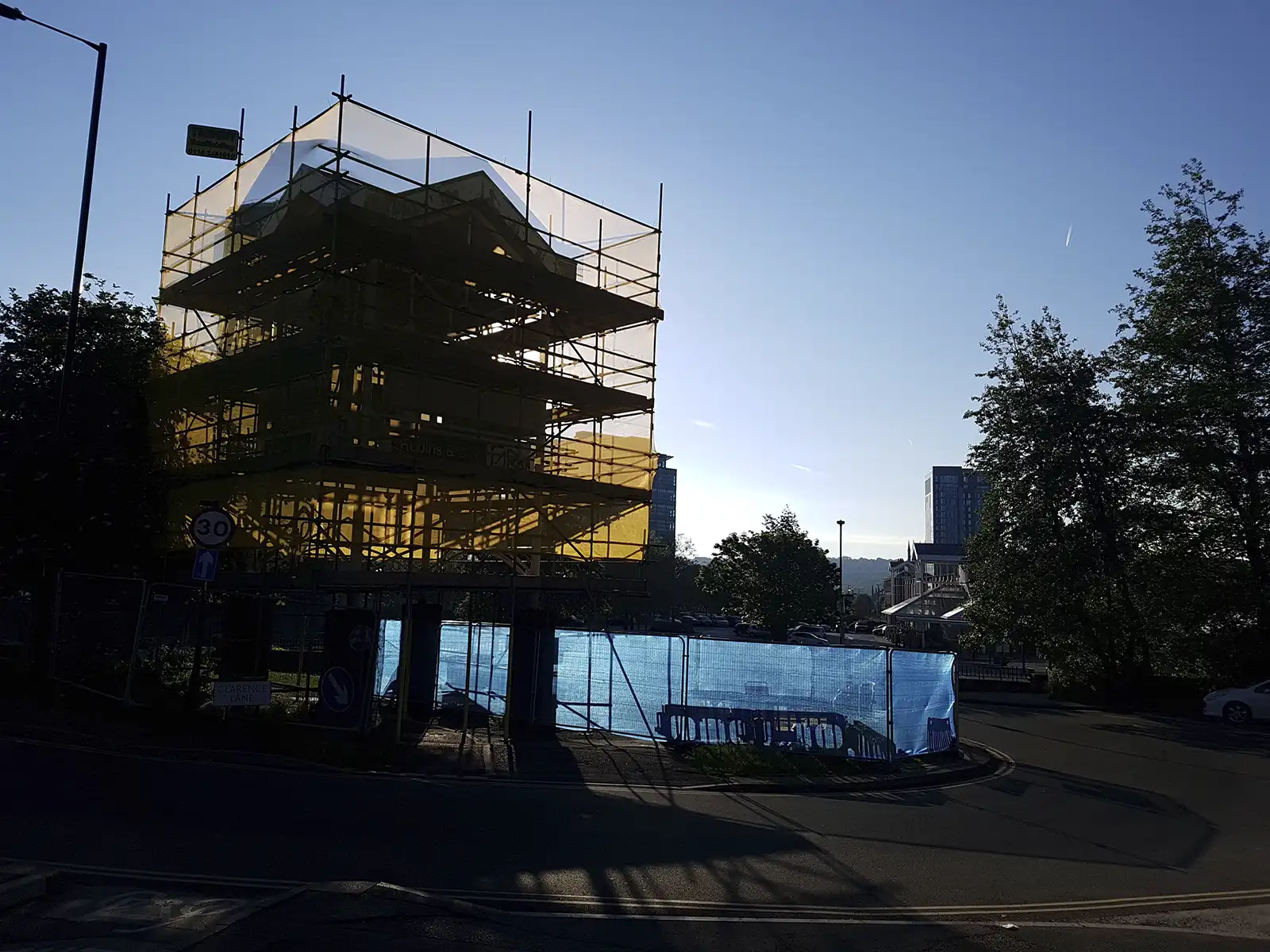
This would normally be my route to work, but I’m working from home today.
The plastic mesh stretched across the scaffolding holds the light. Backlit, this structure appears as a mass of intersecting lines and angles that spill across the pavement and seem to dissolve its solidity, making it blend and connect with the trees and the road.
Walk to the shops: London Road, Sheffield, 11.50 am 11 July 2020
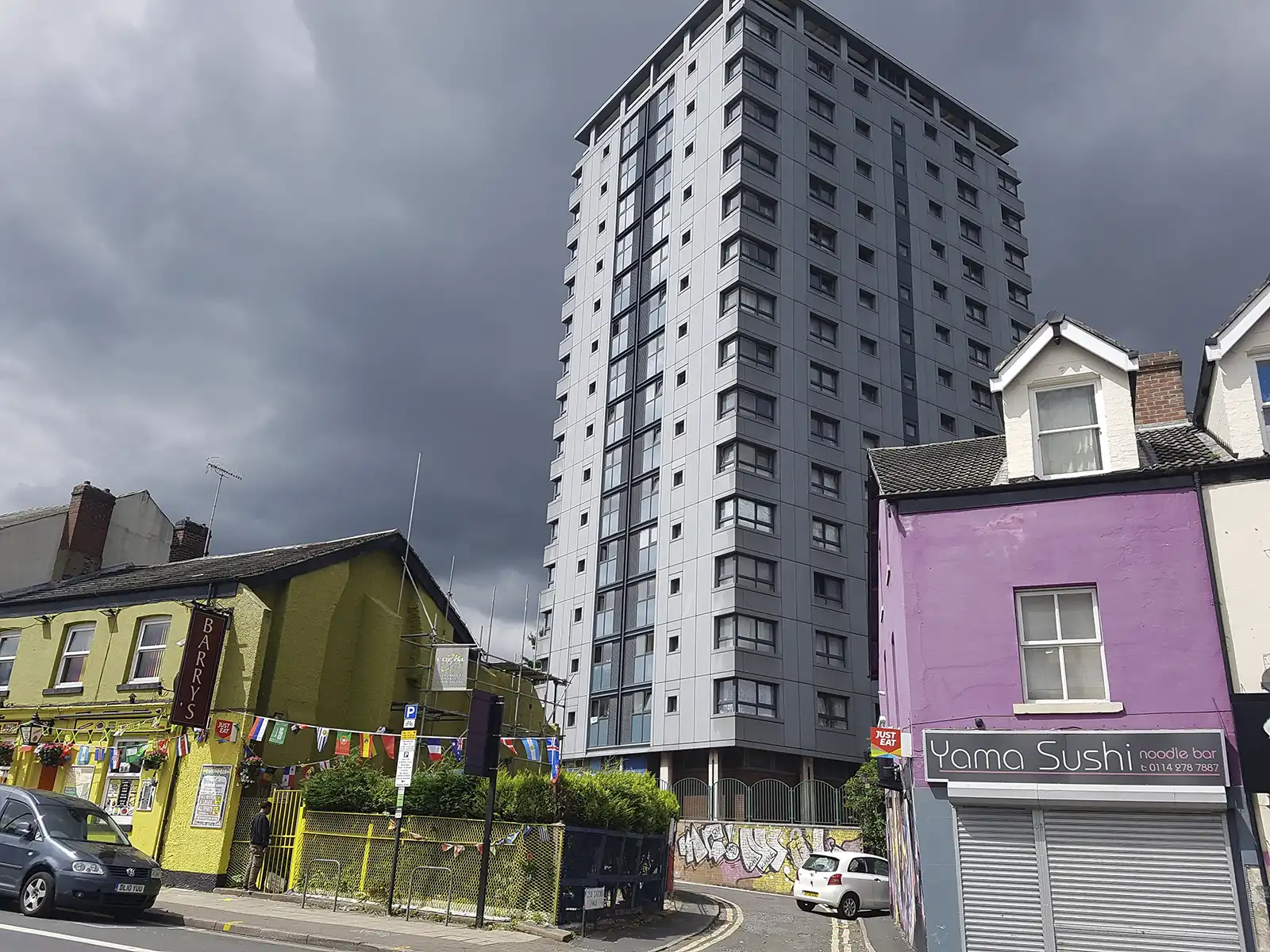
I’m walking to Ozmen’s ‘international supermarket’ on John Street via London Road, one of the most culturally diverse areas in Sheffield. A heavy, leaden sky presses down on London Road and the tower block pushes back against it. At street level, the strong summer sunlight that is highlighting the vivid colours of the smaller street-level buildings and the graffiti seem to have a more diffuse kind of energy. The multi-coloured flag bunting strung over Barry’s beer garden flaps languorously in breeze.
Walk to work: University of Leeds campus, 8.46am 13 Nov 2020
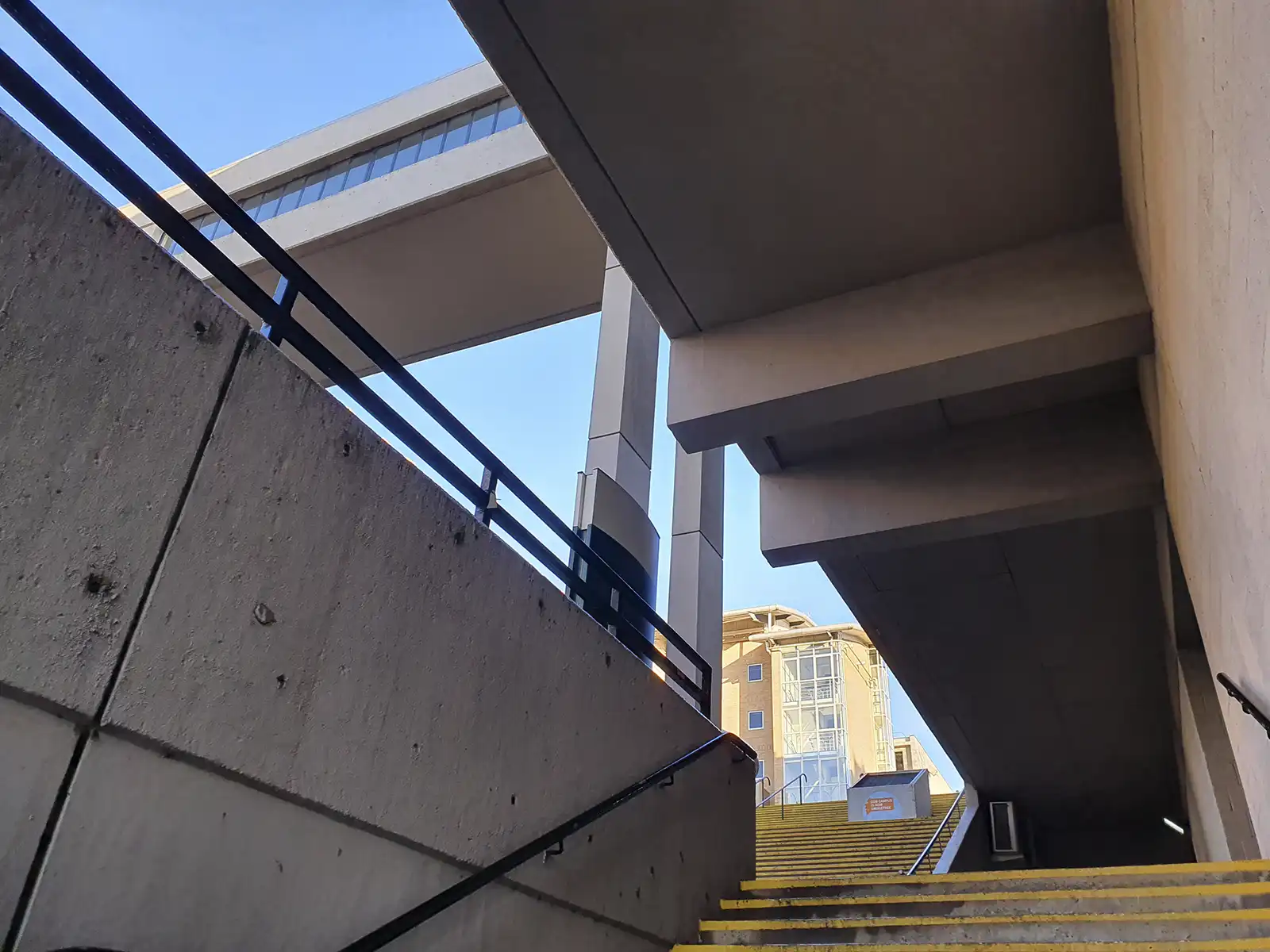
Sunlight is creating a strong contrast between open bright space at the top of the stairs and the shadowy angular passage that needs to be negotiated to get there. It highlights the texture of the thick hard concrete slabs on the wall and the low heavy ceiling halfway up the stairs. I’m aware of looking up towards the light, readying myself to climb and turn, whilst being careful to place my feet safely on the steep, narrow steps with their clumsy, flaky yellow edges. I’m thinking about the emerging into the bright sunlight but also wondering what could be lurking in the dark recess halfway up. In early autumn dead leaves often gather there. Previously, I’ve seen thick cardboard stashed there, too; I think someone was sleeping there. I can feel the brightness pulling me up physically and mentally, but that feeling is tempered by the awkward and shadowy space I have to pass through before I get there.
Atmosphere as scenographic attunement
Each of these atmospheric moments can be communicated, more or less, using a similar set of compositional concerns to theatrical scenography. The elements of light/darkness, colour, texture, structure, space, volume, scale, pattern and rhythm are experienced in relation to the modifiers of movement, intensity, contrast and transformation. The elements that are traditional to theatre practice need to be expanded in urban settings to include the weather (including sunlight and cloud, moisture, temperature and wind) and the seasons. This second set of elements are a reminder, as Tim Ingold says, that people’s relationship with the world “in the open” is immersive and dynamic::
[…] the open world that people inhabit is not prepared for them in advance. It is continually coming into being around them. It is a world, that is, of formative and transformative processes32.
The examples above suggest these elements in each instance seemed to be operating as part of the formation of atmosphere. In each of them light, as part of weather, has a «critical agency in the landscape’s vitality»33. But light’s agency is not self-contained and separate from the rest of the «vibrant» matter34 of these scenes. Instead, it is noticeably part of «the creative potential of a world-in-formation» and «caught up in a current of continual generation»35.
In some examples, the light (or the weather) seems to acting as a metaphor in ways that are familiar to the creation and reception of scenography. On London Road (example 4), the storm clouds and the sunlight seem to come into some kind of uneasy alignment with the buildings that is underscored by the social and cultural history of the place. In the final example on the University of Leeds steps, the sunlight suggests relief or hopefulness – the light at the end of the tunnel – in contrast to the dark corners.
However, the affect of light is not only metaphorical; it also relates to the vibrancy of light and the way it works in combination with other elements of the environment in the process of atmosphere formation. Böhme explains that atmospheres are not things in themselves, but «a floating in-between, something between things and the perceiving subjects». This in-between is filled with the radiating presence – the «ecstasy» – of things36. For example,
Through colour, the thing asserts its presence in space and radiates into it. Through its colourfulness, the individual thing organizes space as a whole, that is, enters into constellations with other things37.
Edensor, writing about the how light affects the way we see landscape, points out that constellations or entanglements of things include sensing body of the perceiver that becomes «inextricably entangled» within the landscape. In this way, the environment can be understood as a «heterogenous medium of sensual, affective and emotional experience»38 very much in the way that a spectator may engage with scenography.
As in theatre scenography, each of the examples contains, to some degree, an articulation of the way I am positioned physically and affectively in relation to the environment, similar to the way a performer might feel enabled, encouraged or challenged by scenography. The way I place my feet, the line of my gaze, the feeling of the proximity of walls, the trajectory of pathways all make an impression and exert an effect on me which, in turn affect the way I pay attention to the “ecstasy” of things that surround me. In the illuminated Waitrose colonnade, for example I am aware of the channelling effect of the structure on my measured walking and the ugly yellow light falling on my hooded face. There is a tension between how I am moving and this might look to an external observer and how I am feeling internally. In contrast, the third example, the “scaffolding” atmosphere, the affect on me is one of empathy or alignment with the atmosphere where I feel myself joining with the ecstasy of the light, mesh, scaffolding in a temporary constellation of unexpected beauty and calm.
Thinking about urban atmospheres as scenographies in the way I have done here focuses on scenographic practice that takes full account of the liveliness and vibrancy of materials and the entanglement of perceiving bodies that is reflected by writers such as Graham and Salter and acknowledges that scenography can be found as well as created.
As Rachel Hann has argued «scenographics» exceed what it is that scenographers do and describe the relationships between bodies and objects that «enact a distinct form of place-orientation»39. A scenographic orientation on urban space pays particular attention to the aesthetic dimension of spaces and atmospheres and to the composition, perception and transformative potential of our surroundings where sensory and embodied modes of knowing are as important as – and complementary to – social and cultural readings. As Ingold says, our entanglement with landscape amounts to a form of communing with our surroundings through opening up to experience that occurs on many levels and registers, including sensual to linguistic, atmospheric to dialogical and haptic to optic40. Scenographic modes of communication and reception are not confined to the production and recognition of mimetic and metaphoric images that trade on the symbolic. They are, especially when considered in relation to the formation of atmospheres, dialogic, dynamic and transformative processes of communing. Alongside the deployment of scenographic interventions that can interrogate relationships with the built environment, we also need to attend to our attunement to atmospheres. This «requires ethnographic methodologies that are sensitive to the emergent and contingent qualities of our experiential worlds»41. Using scenographic sensibilities we can explore urban experience through attuning ourselves to the elements of our surroundings that engender atmosphere and evoke physical affects, emotions, memories and imaginative connections. Scenographic practice and theory can illuminate affective and embodied experience of space and, in conjunction with understanding about socio-spatial aspects of urban design and visual, multimodal, and material methods of investigating cities, could make a significant contribution to understanding to affective and creative relationships between people and urban environments.
- Kathleen Stewart, Ordinary Affects, Duke University Press, Durham NC 2007. ↩
- Ivi, p. 5. ↩
- Kathleen Stewart, Atmospheric Attunements, in «Environment and Planning D: Society and Space», n. 29, pp. 445 – 453: 445. ↩
- Dorita Hannah, Event-Space: Theatre Architecture and the Historical Avant Garde, Routledge, Abingdon 2019; Marvin Carlson, The City as Theatre, in Arnold Aronson (ed.), The Routledge Companion to Scenography, Routledge, Abingdon 2018, pp. 290-294; Anthony Vidler, The Scenes of the Street and Other Stories, Random House, New York 2011. ↩
- Gernot Böhme, Atmospheric Architectures: The Aesthetics of Felt Spaces, Bloomsbury Academic New York 2017 (Architektur und Atmosphäre, Fink, Padernborn 2013). ↩
- Shauna Janssen, Performance design as mnemonic device for critical engagement with the spatial politics of urban change: the ARCADE project, in «Theatre and Performance Design», vol. 5, issue 3-4, 2019, pp. 195-211. ↩
- Jekaterina Lavrinec, Urban Scenography: emotional and bodily experience, in «Limes: Borderland Studies», vol. 6, 2013, p. 27. ↩
- Ivi, p. 29. ↩
- Sodja Lotker, Richard Gough, On Scenography editorial, in «Performance Research», vol. 18, issue 3, 2013, pp. 3-6: 6. ↩
- Ivi, p. 3. ↩
- Joslin McKinney, Seeing scenography: scopic regimes and the body of the spectator, in Arnold Aronson (ed.), The Routledge Companion to Scenography, cit., pp. 102-118; Joslin McKinney, Scenographic materiality: Agency and Intra-Action in stage designs by Katrin Brack, in Birgit Wiens (ed.), Contemporary Scenography: Practices and Aesthetics in German Theatre, Arts and Design, Bloomsbury Methuen, London 2019, pp. 57-72; Rachel Hann, Beyond Scenography, Routledge, Abingdon 2019; Yaron Shyldkrot, Mist opportunities: haze and the composition of atmosphere, in «Studies in Theatre and Performance», vol. 39, issue 2, 2019, pp. 147-164; Katherine Graham, The play of light: rethinking mood lighting in performance, in «Studies in Theatre and Performance», 2020. ↩
- Richard C. Beacham (ed.), Adolphe Appia: Essays, Scenarios, and Designs, University of Michigan Press, Ann Arbor 1989, p. 106. ↩
- Katherine Graham, The play of light: rethinking mood lighting in performance, in «Studies in Theatre and Performance», cit., p. 2. ↩
- Linda Essig quoted ivi, p. 3. ↩
- Ivi, p. 5. ↩
- Ivi, p. 14. ↩
- Ivi, p. 5. ↩
- Chris Salter, Participation, interaction, atmosphere, projection: new forms of technological agency and behavior in recent scenographic practice, in Arnold Aronson (ed.), The Routledge Companion to Scenography, cit., pp. 161-180: 174. ↩
- Arnold Aronson, Introduction: scenography or design, ivi, pp. 1-15: 7. ↩
- Cfr. Joslin McKinney, Scenography, spectacle and the body of the spectator, in «Performance Research», vol. 18, issue 3, 2013, pp. 63 -74; Joslin McKinney, Seeing scenography: scopic regimes and the body of the spectator, cit. ↩
- Sodja Lotker, Richard Gough, On Scenography editorial, cit., p. 6. ↩
- Tonino Griffero, The atmospheric “skin” of the city, in «Ambiances», 2013 (La pelle della città. Per un’atmosfera urbana, in Pina De Luca (a cura di), Visioni metropolitane, Guerini e Associati, Milano 2014, pp. 21-28); Michael Buser, Thinking through non-representational and affective atmospheres in planning theory and practice, in «Planning Theory», vol. 13, issue 3, 2014, pp. 227-243; Mikkel Bille et al., Staging atmospheres: Materiality, culture, and the texture of the in-between, in «Emotion, Space and Society», vol. 15, 2015, pp. 31-38; Tim Edensor, Light Design and Atmosphere, in «Visual Communication», vol. 14, issue 3, 2015, pp. 331-350; Tim Edensor and Shanti Sumartojo, Designing Atmospheres: introduction to Special Issue, in «Visual Communication», vol. 14, issue 3, 2015, pp. 251-265; Jean-Paul Thibaud, The Sensory Fabric of Urban Ambiances, in «The Senses and Society», vol. 6, issue 2, 2011, pp. 203-215; Jean Paul Thibaud, Urban ambiances as common ground?, in «Lebenswelt», vol. 4, issue 1, 2014, pp. 282-295; Jean Paul Thibaud, The backstage of urban ambiances: When atmospheres pervade everyday experience, in «Emotion, Space and Society», vol. 15, 2015, pp. 39-46. ↩
- Ivi. ↩
- Gernot Böhme, Atmospheric Architectures: The Aesthetics of Felt Spaces, cit., pp. 157-166. ↩
- Ivi, p. 165. ↩
- Cfr. Katherine Graham, The play of light: rethinking mood lighting in performance, cit. ↩
- Cfr. Chris Salter, Participation, interaction, atmosphere, projection: new forms of technological agency and behavior in recent scenographic practice, cit. ↩
- Rachel Hann, Beyond Scenography, cit., p. 133. ↩
- Cfr. Chris Salter, Entangled: Technology and the Transformation of Performance, The MIT Press, Cambridge Mass 2010. ↩
- Erika Fischer-Lichte, The Transformative Power of Performance, Routledge, Abingdon 2008, p. 50. ↩
- Gernot Böhme, Atmospheric Architectures: The Aesthetics of Felt Spaces, cit., p. 78. ↩
- Erika Fischer-Lichte, The Transformative Power of Performance, cit.; Tim Ingold, Earth, sky, wind, and weather, in «Journal of the Royal Anthropological Institute» (N.S.), 2007, Volume 13, Issue s1, pp. S19-S38. ↩
- Tim Edensor, Seeing with light and landscape: a walk around Stanton Moor, in «Landscape Research», n. 42, issue 6, 2017, pp. 616-633: 631. ↩
- Jane Bennett, Vibrant Matter: a political ecology of things, Duke University Press, Durham NC 2010. ↩
- Tim Ingold, Earth, sky, wind, and weather, cit. ↩
- Gernot Böhme, Atmosphere as the Fundamental Concept of a New Aesthetics, in «Thesis Eleven», vol. 36, 1993, pp. 113 -126: 121. ↩
- Gernot Böhme, Atmospheric Architectures: The Aesthetics of Felt Spaces, cit., p. 51. ↩
- Tim Edensor, Aurora Landscapes: Affective Atmospheres of Light and Dark, in Karl Benediktsson e Katrin Anna Lund (eds.), Conversations with Landscape, Ashgate, London 2010, pp. 227-240: 231. ↩
- Rachel Hann, Beyond Scenography, cit., p. 29. ↩
- Tim Ingold, Epilogue, in Karl Benediktsson e Katrin Anna Lund (eds.), Conversations with Landscape, Ashgate, London 2010, pp. 241- 251: 251. ↩
- Shanti Sumartojo, Tim Edensor, Sarah Pink, Atmospheres in Urban Light, in «Ambiances», n. 5, 2019. ↩
